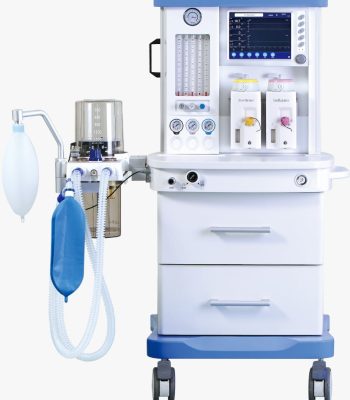Project Report For Anesthesia Machine
Introduction
Project Report For Anesthesia Machine is as follows.
The anaesthetic machine, also known as an anaesthesia machine, is a medical equipment that generates and mixes a fresh gas flow of medical gases and inhalational anaesthetic drugs in order to induce and maintain anaesthesia.
The machine is frequently used in conjunction with a mechanical ventilator, breathing system, suction machinery, and patient monitoring devices; technically, the term “anaesthetic machine” refers only to the component that generates the gas flow, but modern machines typically integrate all of these devices into a single combined freestanding unit, which is colloquially referred to as the “anaesthetic machine” for simplicity.
The continuous-flow anaesthetic machine, also known as “Boyle’s machine” in the developed world, is designed to provide an accurate supply of therapeutic gases mixed with an accurate concentration of anaesthesia vapour, and to deliver this constantly to the patient at a safe level of flow and pressure.
Simpler anaesthetic apparatus, such as the triservice anesthetic apparatus, a streamlined anaesthesia delivery system developed for the British Defence Medical Services that is light and portable and can be used for ventilation even when medical gases are not available, may be used in special circumstances. This apparatus features unidirectional valves that suck in ambient air, which may then be enhanced with oxygen from a cylinder using a set of bellows.

Types Of Anesthesia Machine
Accurate Anaesthetic Delivery :- Anaesthesia machines are designed to provide patients with accurate and regulated doses of anaesthetic gases and drugs. They contain sophisticated monitoring systems that continually evaluate factors like oxygen concentration, airway pressure, and patient breathing patterns, allowing anesthesiologists to alter anaesthesia delivery as needed to maintain the appropriate anaesthetic depth.
Patient Safety :- Anaesthesia devices have a variety of safety elements to safeguard the safety of patients. They have fail-safe features that prohibit the administration of too much anaesthesia or gas combinations, lowering the risk of problems. Integrated alarms notify medical personnel if any parameters vary from the prescribed range, allowing for rapid action and the prevention of undesirable consequences.
Versatility :- Anaesthesia machines are flexible and adaptable to a broad variety of surgical procedures and patient needs. Depending on the unique needs of the patient and the surgical process, they can provide general anaesthesia (inhalation or intravenous), regional anaesthesia, or sedation.
Efficient Waste Gas Management :- Scavenging devices on anaesthesia equipment catch and eliminate waste anaesthetic gases from the operating room. This protects both healthcare staff and patients from potentially dangerous gases, lowering the risk of long-term health consequences.
Integration with Monitoring Devices :- Modern anaesthesia equipment frequently integrates with other monitoring devices, such as pulse oximeters, capnographs, and electrocardiogram (ECG) machines, in a smooth manner. This connection enables thorough vital sign monitoring, assuring early identification of any irregularities and allowing for prompt actions.
Improved Workflow and Efficiency :- Anaesthesia machines are ergonomically built to make them easier to operate and more efficient for healthcare personnel. They include user-friendly interfaces that enable anesthesiologists to swiftly alter settings and monitor patient characteristics. This improves workflow and saves time during crucial surgical operations.
Project Report Sample On
Anesthesia Machine
Get Completely Custom Bankable Project Report
Market Potential for Anesthesia Machine
In 2020, the market for anaesthesia devices was estimated to be worth $13,560.00 million, and by 2030, it is expected to have grown to $28,381.86 million, with a CAGR of 8.10%.
The anesthesia equipment industry will have to remain profitable throughout the analysis period, aided by the support of various government agencies and increasing initiatives to promote surgical interventions. Recent trends in the global market include a growing preference for minimally invasive surgery, increasing the need for state-of-the-art anesthesia machines and other surgical equipment.
Minimally invasive surgery is widely preferred due to smaller incisions, shorter hospital stays, faster healing, less scarring and pain, and lower risk of complications than open surgery. They also help keep enormous medical costs in check, which is why demand is growing rapidly around the world.
Due to the prevalence of numerous disorders, surgical operations are expanding at an alarming rate throughout the world. Anaesthesia is important because every patient who has surgery is sedated to manage discomfort throughout the procedure. Because of the great incidence of these medical disorders, the most common surgical operations performed worldwide are orthopaedics, cardiology, and neurology.
The rising number of surgical operations is likely to boost the worldwide anaesthesia devices market forward. The demand for anesthesia machines is further driven by increased health insurance availability and favorable reimbursement models. The number of surgeries is increasing due to the increase in lifestyle-related diseases, accidents, and sports injuries, and the market demand is increasing.

